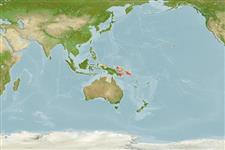أشلاق (القروش و الشفانين) (sharks and rays) >
Orectolobiformes (Carpet sharks) >
Hemiscylliidae (Bamboo sharks)
Etymology: Hemiscyllium: hemi-, from hemisys (Gr.), half, presumably referring to similarity and/ or close affinity to Scyllium (=Scyliorhinus, now in Scyliorhinidae) and/or Chiloscyllium; skylion, Greek for dogfish or small shark. (See ETYFish); michaeli: In honor of photographer and aquarist Scott W. Michael, who brought the difference between this species and H. freycineti to the authors’ attention, and for contributing information and photographs to the senior author’s research on Indo-Pacific fishes. (See ETYFish).
Environment: milieu / climate zone / depth range / distribution range
البيئة
بحري قاعية التغذية و المعيشة; نطاق العمق 2 - 20 m (Ref. 90102). Tropical
Westen Pacific Ocean: Eastern Papua New Guinea.
الحجم / وزن / العمر
Maturity: Lm ? range ? - ? cm
Max length : 69.5 cm TL ذكر/ مختلط الجنس; (Ref. 83755); 25.7 cm TL (female)
وصف مختصر
مفاتيح التعريف | الوصف الخارجي | قياسات المظهر الخارجي
The species was previously confused with H. freycineti, which is restricted to Papua Barat Province (western New Guinea), Indonesia. The two species differ primarily in colour pattern, which provides the best means of separating the various members of the genus. Both species have a profuse covering of brown spots with a large black or brown ocellated marking on the middle of the side, just behind the head. The spots of H. michaeli are generally denser, larger, and distinctly polygonal, remarkably similar to the spots of a leopard. In contrast those of H. freycineti are round to transversely elongate and are darkened at regular intervals to form 8-9 bars or saddle-like markings (including those on the tail). The difference in spot pattern between the two species is particularly evident in the head region. In addition, H. michaeli possesses a vivid ocellate black spot behind the head, whereas the black spot of H. freycineti is generally not well defined. Comparison of the mitochondrial ND4 gene also supports the species-level separation of these species.
Usually encountered on coastal fringing reefs and patch reefs during night diving, although it is sometimes seen during the day, sheltering under rocky outcrops or tabular corals (Ref. 83755).
Life cycle and mating behavior
Maturities | التكاثر | Spawnings | Egg(s) | Fecundities | Larvae
Allen, G.R. and C.L. Dudgeon, 2010. Hemiscyllium michaeli, a new species of Bamboo Shark (Hemiscyllidae) from Papua New Guinea. aqua, Int. J. Ichthyol. 16(1):19-30. (Ref. 83755)
IUCN Red List Status (Ref. 130435)
استخدامات بشرية
أدوات
تقارير خاصة
Download XML
مصادر علي الأنترنت
Estimates based on models
Phylogenetic diversity index (Ref.
82804): PD
50 = 0.5020 [Uniqueness, from 0.5 = low to 2.0 = high].
Bayesian length-weight: a=0.00407 (0.00181 - 0.00918), b=3.09 (2.89 - 3.29), in cm total length, based on LWR estimates for this (Sub)family-body shape (Ref.
93245).
مستوى غذائي (Ref.
69278): 3.4 ±0.3 se; based on size and trophs of closest relatives
Fishing Vulnerability (Ref.
59153): Moderate to high vulnerability (48 of 100).
